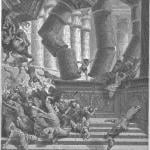Today is Groundhog Day. The one day a year Americans put their jovial hope in a furry terrestrial creature. That is what is fun (and strange) about Groundhog Day. After a long winter, we are looking for a little relief. A little hope.
But I am probably not alone in turning my thoughts to the movie starring Bill Murray. If you haven’t seen it, you should. It is a fantastic story.
The movie is ironic because far from the hope of relief, Bill Murray finds himself reliving the same day –Groundhog Day – over and over again. As you’d expect, he fights against it, then gives into it, then gives up, and…well, I won’t spoil the end.
What is interesting about both the movie and the holiday is that Groundhog Day is about cycles, patterns. The power of repetition and the hope of progress.
An Array of Patterns
We are all facing an array of patterns in our lives. The seasons are one of the clearest. But there are many. Some of these patterns are circumstantial. What you might call seasonal. Some of them are deeper rooted and will stay for longer, less defined amounts of time.

How do these latter kinds of patterns develop? Through repetition.
Another irony in the Bill Murray movie is that we see him living the same day over and over and we start to notice the hilarious patterns he must necessarily repeat – passing a neighbor at this time of the day; the cat in the tree. Over and over, these things happen. Stuck in a time loop, he encounters these realities with frustrating monotony.
What is ironic about this is that Bill Murray’s character is doing the exact same thing in his own life, prior to getting stuck in the time loop. He has developed patterns through repetition. He is kind of a jerk – a pattern developed after years and years of self-centeredness. He constantly overlooks the beauty around him – because of the repetition of only focusing on what furthers his ambition and ego.
His time loop ends up being an invitation to break the patterns of his life. The whirlpool of living the same day over and over gives him another chance to adopt a different pattern, to see different things. And you can see it unfold as the movie progresses. He sees opportunities to serve and help others rather than just desperately trying to get out of the time loop (and back into his old patterns). In other words: he starts to see opportunity rather than obstacles around him. And in the end, it changes him for the better.
Changing Patterns
The patterns we have developed are called System One Thinking. They are the shortcut assumptions our brains have created to save time and energy. It is the undercurrent of our worldview and our behavior.
In order for these patterns to change we have to a) be aware of them and b) see that they are no longer working in our lives.

It is early in 2021. The world has been through a lot. You have been through a lot. So have I. We have developed patterns to cope. Familiar ways of reacting to the stimulus around us.
But often our established patterns are not healthy patterns.
In the end, Bill Murray discovers that it is not about changing and perfecting the circumstances within his time loop but about learning how to steward his character more honestly and effectively. How to live a more meaningful life.
In the silliness of Groundhog Day, there is also an invitation. Come winter or spring, what patterns dominate our lives? Are they working? What can we do to learn rather than reinforce those patterns that are broken?












